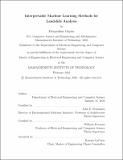Interpretable Machine Learning Methods for Landslide Analysis
Author(s)
Gupta, Deepankar
DownloadThesis PDF (10.77Mb)
Advisor
Fernandez, John E.
Freeman, William
Terms of use
Metadata
Show full item recordAbstract
Landslides have the power to alter terrain, reshape ecosystems, damage anthropogenic structures, and destroy entire communities. On March 31, 2017, Mocoa fell victim to a devastating landslide that claimed 254 lives and left hundreds more missing. Given the region’s high frequency of landslides, conducting a formal investigation of its landslides and the factors that make the region susceptible to them is urgent. In this project, we use machine learning to computationally study landslide detection, the likelihood of past landslides occurrence, and landslide susceptibility, or risk, in the Mocoa region. The region’s geographical and climate features make it elusive to remote-sensing technologies and difficult to survey. We combat the resulting data sparsity by carefully designing learning tasks and data pipelines for detection and susceptibility. We meaningfully extract 20 features with scientific or computational basis. We then provide a comprehensive evaluation of four different machine learning models: logistic regression (LR), decision tree (DT), random forest (RF), and convolutional neural network (CNN) on both the landslide detection and the landslide susceptibility tasks. All four models displayed performance that was significantly better than random on both tasks. CNN models achieved the highest classification accuracy in the area of interest (AOI) for both tasks, earning 87.3% for detection and 92.5% for susceptibility.We also probed all four types of models using multiple techniques to determine features important to their decision making. Across the landslide detection models, slope, aspect, and the presence of claystones were the most consistent important features for inferring past landslide likelihood. For landslide susceptibility, we found slope, aspect, distance from fault lines, and the presence of claystones to be the most consistent important features for inferring landslide risk. The reliance of the models on slope and aspect does not surprise due to landslides involving mass movement from high to low points of elevation. Less surprising, the presence of claystones also appears to be important to both landslide tasks. The connection between claystones and Mocoan landslides merits further investigation. The importance of distance from fault lines to susceptibility models suggests that seismic activity at fault lines is a key trigger for Mocoan landslides.
Date issued
2022-02Department
Massachusetts Institute of Technology. Department of Electrical Engineering and Computer SciencePublisher
Massachusetts Institute of Technology